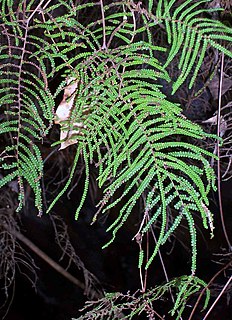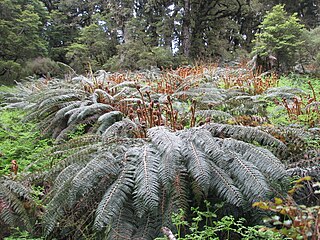
The tree ferns are arborescent (tree-like) ferns that grow with a trunk elevating the fronds above ground level, making them trees. Most tree ferns are members of the "core tree ferns", belonging to the families Cyatheaceae, Dicksoniaceae, Metaxyaceae, and Cibotiaceae in the order Cyatheales. It is estimated that Cyatheales originated in the early Jurassic, and is the third group of ferns known to have given rise to tree-like forms. The others are the extinct Tempskya of uncertain position, and Osmundales where the extinct Guaireaceae and some members of Osmundaceae also grew into trees. In addition there was the Psaroniaceae and Tietea in the Marattiales, which is the sister group to true ferns.

A fern is a member of a group of vascular plants that reproduce via spores and have neither seeds nor flowers. The polypodiophytes include all living pteridophytes except the lycopods, and differ from mosses and other bryophytes by being vascular, i.e., having specialized tissues that conduct water and nutrients and in having life cycles in which the branched sporophyte is the dominant phase. Ferns have complex leaves called megaphylls, that are more complex than the microphylls of clubmosses. Most ferns are leptosporangiate ferns. They produce coiled fiddleheads that uncoil and expand into fronds. The group includes about 10,560 known extant species. Ferns are defined here in the broad sense, being all of the Polypodiopsida, comprising both the leptosporangiate (Polypodiidae) and eusporangiate ferns, the latter group including horsetails, whisk ferns, marattioid ferns, and ophioglossoid ferns.

Bracken (Pteridium) is a genus of large, coarse ferns in the family Dennstaedtiaceae. Ferns (Pteridophyta) are vascular plants that have alternating generations, large plants that produce spores and small plants that produce sex cells. Brackens are noted for their large, highly divided leaves. They are found on all continents except Antarctica and in all environments except deserts, though their typical habitat is moorland. The genus probably has the widest distribution of any fern in the world.

This article relates to the flora of New Zealand, especially indigenous strains. New Zealand's geographical isolation has meant the country has developed a unique variety of native flora. However, human migration has led to the importation of many other plants as well as widespread damage to the indigenous flora, especially after the advent of European colonisation, due to the combined efforts of farmers and specialised societies dedicated to importing European plants & animals.

The order Cyatheales, which includes most tree ferns, is a taxonomic order of the fern class, Polypodiopsida. No clear morphological features characterize all of the Cyatheales, but DNA sequence data indicate the order is monophyletic. Some species in the Cyatheales have tree-like growth forms from a vertical rhizome, others have shorter or horizontal expanding rhizomes.

Alsophila dealbata, synonym Cyathea dealbata, commonly known as the silver fern or silver tree-fern, or as ponga or punga, is a species of medium-sized tree fern, endemic to New Zealand. The fern is usually recognisable by the silver-white colour of the under-surface of mature fronds. It is a symbol commonly associated with the country both overseas and by New Zealanders themselves.

The New Zealand national netball team, commonly known as the Silver Ferns, represent New Zealand in international netball. The team take their nickname from the Silver Tree Fern, which is an emblem for many New Zealand sports teams. The Silver Ferns were formed in 1938 as a representative New Zealand team to tour Australia. To date, they have been one of the most dominant national netball teams in the world, along with Australia, and have a winning record against most other netball nations. The Silver Ferns are current world champions and ranked second in the INF World Rankings, behind Australia.

Sphaeropteris medullaris, synonym Cyathea medullaris, commonly known as mamaku or black tree fern, is a large tree fern up to 20 m tall. It is distributed across the south-west Pacific from Fiji to Pitcairn Island. Its other Māori names include katātā, kōrau, or pītau.

Alsophila smithii, synonym Cyathea smithii, commonly known as the soft tree fern or kātote, is a species of tree fern from New Zealand.

Joline Henry is a New Zealand netball player. Henry is a current member of the New Zealand national netball team, the Silver Ferns, and has played for the Waikato/Bay of Plenty Magic (2008-2009) and the Northern Mystics (2010-2011) in the ANZ Championship. In 2012, Henry is with the Central Pulse for the 2012 ANZ Championship.

Hymenophyllum nephrophyllum, the kidney fern, is a filmy fern species native to New Zealand. It commonly grows on the forest floor of open native bush. Individual kidney-shaped fronds stand about 5–10 cm tall. In hot weather they shrivel up to conserve moisture, but open up again when the wet returns. This species has very thin fronds which are only four to six cells in thickness. In the Māori language they are also called raurenga.

The New Zealand flag debate is a periodic question over whether the national flag should be changed. For several decades, alternative designs have been proposed, with varying degrees of support. There is no consensus among proponents of changing the flag as to which design should replace the current one. Common criticisms of the existing form of the New Zealand flag are its similarity to the Australian flag and the inappropriateness of retaining the Union Jack in the design. A series of polls conducted since the 1970s have shown that a majority of New Zealanders prefer the current flag.

Gleichenia dicarpa, commonly known as pouched coral fern or tangle fern, is a small fern of the family Gleicheniaceae found in eastern Australia, New Caledonia and New Zealand. It forms tangled thickets in wet places such as swamps and riverbanks.

Gleichenia microphylla is a small fern growing in Australia and New Zealand.

Hymenophyllum australe, commonly known as austral filmy fern, is a relatively large rupestral and epiphytic fern, indigenous to eastern Australia and New Zealand. It belongs to the unique Hymenophyllum genus, which are characterised by their thin membranous fronds that are seldom more than one cell thick, with the exception of regions over and around veins. Hymenophyllum australe is distinctive in that the fronds are typically thicker than other Hymenophyllum species, often being up to 2-3 cells thick.

Polystichum vestitum, commonly known as the prickly shield fern or pūnui (Maori), is a hardy, evergreen or semi-evergreen ground fern.

Nephrolepis cordifolia, is a fern native to the global tropics, including northeastern Australia and Asia. It has many common names including fishbone fern, tuberous sword fern, tuber ladder fern, erect sword fern, narrow sword fern and ladder fern, and herringbone fern. It is similar to the related fern Nephrolepis exaltata.

Pyrrosia eleagnifolia, commonly known as the leather-leaf fern, or ota in Māori, is a climbing fern endemic to New Zealand. P. eleagnifolia has thick, fleshy rounded leaves, and grows both on the ground and as an epiphyte.

Hymenophyllum rarum, the narrow filmy-fern, is a species of fern from the family Hymenophyllaceae. This thin-leaved fern is commonly found in New Zealand and Tasmania, growing in patches on rocks and is epiphytic on trees and tree ferns, growing in moist gullies or rainforests. A rather drought tolerant species often found at exposed sites ranging from coastal to montane areas. Forming extensive, interwoven and creeping patches with its thin long (creeping) rhizomes sparsely covered in red-brown hairs, easily recognised by its membranous grey-green fronds, the smooth margins of the pinnae, ultimate segments and indusia; and by the sunken sori in the uppermost segments of the uppermost pinnae. The species can be found throughout Tasmanian rainforests as well as occurring in New South Wales, Victoria and New Zealand on the North and South Islands as well as, Stewart, Chatham and Auckland Islands.

Pakihi or pākihi is a vegetation association unique to the West Coast of the South Island of New Zealand, characterised by flat boggy land with infertile, waterlogged soil on which only rushes, ferns, moss, and mānuka grow.




















